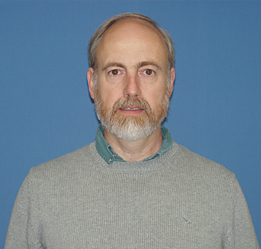
Dana Browne
Professor of Physics
Associate Chair for Instruction
Ph.D., 1982, Stanford University
Office:219-B Nicholson Hall
Phone:(225) 578-6843
FAX:(225) 578-5855
Dept. E-mail:browne@phys.lsu.edu
LSU E-mail:phowne@lsu.edu
Mail:
Department of Physics and Astronomy
202 Nicholson Hall
Louisiana State University
Baton Rouge, LA 70803-4001
Research Seminar for the MNS Program
Present Research Interests
My major research area concerns the behavior of systems of many degrees
of freedom whose steady state is far from thermal equilibrium.
Examples include fluid motion, chemical reactions, traffic flow,
stocks, and biological systems. These systems are composed of many
objects, whose individual behavior causes interactions between the
objects. In the case of traffic, for example, one can imagine the
driving behavior of one driver causing other drivers to alter their
behavior, possible resulting in accidents or traffic jams.
For many years, the field of statistical mechanics was the study
of predicting the collective behavior of roughly 1023 atoms or
molecules. In essence, starting with models for the forces between the
water molecules, predict the properties of water. My area of research
extends this field to study objects that are rather different from
atoms. We want to know: can we use ideas and techniques from statistical
mechanics to understand the behavior of these collections of other objects.
Many of these systems can undergo spontaneous reorganization
of its steady state behavior (onset of turbulence, chemical reaction
waves, onset of traffic jams, cellular reorganization and
differentiation of biological character). We study how these
nonequilibrium "phase transitions" are similar to equilibrium phase
transitions (like freezing or boiling), and also try to understand the
behavior near the transition using ideas so successful in equilibrium
transitions such as scale invariance and the renormalization group.
Electronic Structure
I also provide theoretical support (models, calculations, or simulations) for the
experimental condensed matter group. Currently we are calculating the properties of
a variety of materials of interest to other members of the condensed matter faculty.
I give one example below.
Band Structure of `BeBe2'
Biophysics
This is a relatively new area, where we use a model of a polymer as a semiflexible rope
to model the backbone of a protein. This model is quite simple and can be easily simulated.
We want to use this model to study how substitution of amino acids can lead to protein
evolution without change in the protein's function.
Folding of Biopolymer Tubes
Selected Publications
-
B. Yu and D. A. Browne,
"Nonequilibrium Critical Behavior from the Master Equation,"
Phys. Rev. E 49 3496 (1994).
-
Barbara S. Helmkamp and Dana A. Browne,
"Inhibition of Mixing in Chaotic Quantum Dynamics,"
Phys. Rev. E 51 1849 (1995).
- N. Mainkar, D. A. Browne, and J. Callaway,
"First-Principles LCGO Calculation of the Magneto-optical Properties
of Nickel and Iron,"
Phys. Rev. B 53 3692 (1996).
- B. D. Rajput and D. A. Browne,
"Lattice Dynamics of II-VI Materials Using Adiabatic Bond Charge Model,"
Phys. Rev. B 53 9052 (1996).
- B. S. Helmkamp and D. A. Browne,
"The Role of the Environment in Chaotic Quantum Dynamics,"
Phys. Rev. Lett. 76 3691 (1996).
- K. Bassler and D. A. Browne,
"Nonequilibrium Critical Phenomena in a Three Species Monomer-Monomer Model,"
Phys. Rev. Lett. 77 4094 (1996).
- K. Bassler and D. A. Browne,
`The Three Species Monomer-Monomer Model:
A Mean-Field Analysis and Monte Carlo Study,"
Phys. Rev. E 55 5225 (1997).
- K. S. Brown, K. E. Bassler, and D. A. Browne,
"Monte Carlo Study of a Two-Species Catalytic Surface Reaction Model,"
Phys. Rev. E 56 3953 (1997).
- B. D. Rajput and D. A. Browne,
"Phonons in CdTe-HgTe Superlattices,"
J. Phys: Condensed Matter 10 3177 (1998).
- K. E. Bassler and D. A. Browne,
"The Three-Species Monomer-Monomer Model in the Reaction-Controlled Limit,"
J. Phys. A: Math. Gen. 31 6309 (1998).
- D. Battogtokh and D. A. Browne,
"Cellular Train,"
Phys. Lett. A 266 359 (2000).
- C. Terzioglu, D. A. Browne, R. G. Goodrich, A. Hassan, and Z. Fisk,
"EPR and magnetic susceptibility measurements on CeB6,"
Physical Review B 23 235110 (2001).
-
R. T. Macaluso, J. L. Sarrao, P. G. Pagliuso, N. O. Moreno, R. G.
Goodrich, D. A. Browne, F. R. Fronczek, and J. Y. Chan,
"Crystal growth and structure determination of LaMIn5 (M = Co, Rh, Ir)"
Journal of Solid State Chemistry 166 245 (2002).
-
A. I. Acatrinei, D. A. Browne, Y. B. Losovyj, D. P. Young, M.
Moldovan, J. Y. Chan, P. T. Sprunger, and R. L. Kurtz,
"Angle-resolved photoemission study and first-principles calculation
of the electronic structure of LaSb2,"
Journal of Physics: Condensed Matter 15 L511 (2003).
-
R. G. Goodrich, D. A. Browne, R. Kurtz, D. P. Young, J. F. DiTusa, P. W. Adams, and D. Hall,
"de Haas--van Alphen measurements of the electronic structure of LaSb2"
Phys. Rev. B 69 125114 (2004).
- A. Yadav and D. A. Browne,
"Interaction of Ising-Bloch Fronts with Dirichlet boundaries,"
Phys. Rev. E 70 036218 (2004).
-
A. Yadav and D. A. Browne,
"Boundary Effects on Localized Structures in Spatially Extended Systems,"
Physica D-Nonlinear Phenomena 219 142 (2006).
-
R. L. Kurtz, D. A. Browne, and G. J. Mankey,
"Final State Effects in Photoemission Studies of the Fermi Surface,"
J. Phys: Condensed Matter 19 355001 (2007).
-
A. B. Karki, D. P. Gauteaux, J. Y. Chan, N. Harrison,
D. A. Browne, R. G. Goodrich, and D. P. Young,
"Magnetotransport properties and the Fermi Surface of single crystal
VB2,"
J. Phys.: Condensed Matter 20 035209 (2008).
-
R. D. Collyer and D. A. Browne,
"Correlations and the Magnetic Moment of MnSi,"
Physica B 403 1420 (2008).
-
S. Guo, D. P. Young, R. T. Macaluso, D. A. Browne, N. L. Henderson,
J. Y. Chan, L. L. Henry, and J. F. DiTusa,
"Discovery of the Griffiths Phase in the Itinerant Magnetic Semiconductor
Fe1-xCoxS2,"
Phys. Rev. Lett. 100 017209 (2008).

This page was updated last on
Tuesday, January 7, 2010


